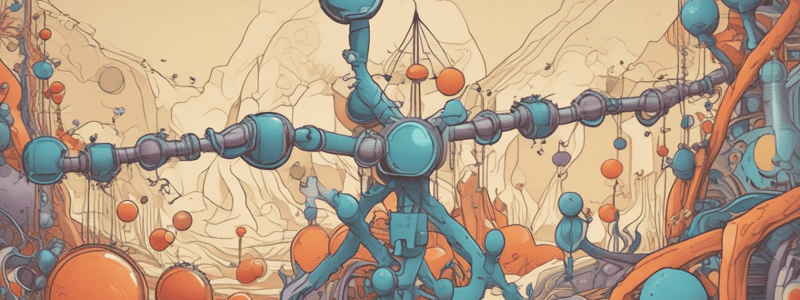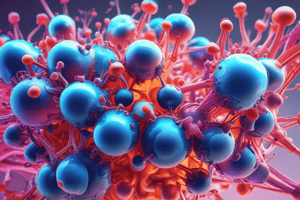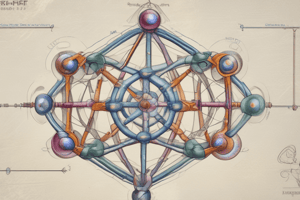Podcast
Questions and Answers
What is a major purpose of the book mentioned in the text?
What is a major purpose of the book mentioned in the text?
- To discuss the principles of bioinorganic chemistry in a non-technical manner
- To provide a collection of facts about bioinorganic chemistry
- To focus solely on the biological functions of selected metal ions
- To extract and organize important principles from research areas in bioinorganic chemistry (correct)
What is a characteristic of metalloproteins that perform a catalytic function?
What is a characteristic of metalloproteins that perform a catalytic function?
- They are only found in dioxygen transport proteins
- They are called metalloenzymes (correct)
- They have a complex protein environment
- They are found in all living organisms
What is a unique function performed by metalloproteins?
What is a unique function performed by metalloproteins?
- Regulation of gene expression
- Cell signaling
- Dioxygen transport (correct)
- Protein synthesis
What is the name of the protein family that includes hemoglobin and myoglobin?
What is the name of the protein family that includes hemoglobin and myoglobin?
What is the function of the iron-porphyrin complex in hemoglobin and myoglobin?
What is the function of the iron-porphyrin complex in hemoglobin and myoglobin?
What is a characteristic of the dioxygen-binding site in hemoglobin and myoglobin?
What is a characteristic of the dioxygen-binding site in hemoglobin and myoglobin?
What is the purpose of the structural changes in hemoglobin upon dioxygen binding?
What is the purpose of the structural changes in hemoglobin upon dioxygen binding?
What is the name of the protein that employs a pair of metal ions in the dioxygen-binding reaction?
What is the name of the protein that employs a pair of metal ions in the dioxygen-binding reaction?
What is the characteristic of the metallic cores in dioxygen transport proteins?
What is the characteristic of the metallic cores in dioxygen transport proteins?
What is a function of metal ions in biology, as discussed in the text?
What is a function of metal ions in biology, as discussed in the text?
What is the name of the molecule depicted in Figure 1.3?
What is the name of the molecule depicted in Figure 1.3?
In what type of organisms is dioxygen bound between two copper atoms?
In what type of organisms is dioxygen bound between two copper atoms?
What is the function performed by the pair of metal ions in hemerythrin (Hr)?
What is the function performed by the pair of metal ions in hemerythrin (Hr)?
What type of chemical reaction is involved in the binding of O2 to the porphyrin-bound iron in hemoglobin?
What type of chemical reaction is involved in the binding of O2 to the porphyrin-bound iron in hemoglobin?
What is the name of the protein that requires redox chemistry to perform a specific function, such as nitrogen fixation?
What is the name of the protein that requires redox chemistry to perform a specific function, such as nitrogen fixation?
What is the name of the protein that regulates the expression of genes and contains a Zn2+ ion?
What is the name of the protein that regulates the expression of genes and contains a Zn2+ ion?
What is the role of metal ions in transcription factor IIIA?
What is the role of metal ions in transcription factor IIIA?
What is the name of the cluster depicted in Figure 1.4 that contains 4Fe and 4S?
What is the name of the cluster depicted in Figure 1.4 that contains 4Fe and 4S?
What is the role of Fe-S clusters in proteins?
What is the role of Fe-S clusters in proteins?
What is the name of the table that lists the redox potentials for several metal ions?
What is the name of the table that lists the redox potentials for several metal ions?
What is the role of metal ions in certain proteins involved in gene regulation?
What is the role of metal ions in certain proteins involved in gene regulation?
What is the function of the MerR protein in metalloregulation of gene expression?
What is the function of the MerR protein in metalloregulation of gene expression?
What is the primary function of metalloenzymes?
What is the primary function of metalloenzymes?
What is the reaction catalyzed by carbonic anhydrase?
What is the reaction catalyzed by carbonic anhydrase?
What is the role of Zn2+ ions in most DNA and RNA polymerases?
What is the role of Zn2+ ions in most DNA and RNA polymerases?
What is the primary function of hydrolytic enzymes?
What is the primary function of hydrolytic enzymes?
What is the reaction catalyzed by superoxide dismutase?
What is the reaction catalyzed by superoxide dismutase?
What is the function of metalloenzymes in nitrogen fixation?
What is the function of metalloenzymes in nitrogen fixation?
What is the role of metal ions in the active site of many hydrolytic enzymes?
What is the role of metal ions in the active site of many hydrolytic enzymes?
What is the function of metalloregulatory systems?
What is the function of metalloregulatory systems?
What is the main reason for preferring divalent zinc in hydrolytic enzymes over other metal ions?
What is the main reason for preferring divalent zinc in hydrolytic enzymes over other metal ions?
What type of redox processes are catalyzed by metalloenzymes?
What type of redox processes are catalyzed by metalloenzymes?
What is the function of the dinuclear copper active site in tyrosinase?
What is the function of the dinuclear copper active site in tyrosinase?
What is the role of the molybdenum atom in sulfite oxidase?
What is the role of the molybdenum atom in sulfite oxidase?
What is the function of ribonucleotide reductase (RR) in DNA biosynthesis?
What is the function of ribonucleotide reductase (RR) in DNA biosynthesis?
What is the function of nitrate reductase in green plants?
What is the function of nitrate reductase in green plants?
What is the function of the zinc(II) ion in liver alcohol dehydrogenase?
What is the function of the zinc(II) ion in liver alcohol dehydrogenase?
What is the role of the dinuclear iron center in ribonucleotide reductase (RR)?
What is the role of the dinuclear iron center in ribonucleotide reductase (RR)?
What is the function of hydrogenases?
What is the function of hydrogenases?
What type of transformations are catalyzed by metalloenzymes in Section 1.3.c?
What type of transformations are catalyzed by metalloenzymes in Section 1.3.c?
In the Krebs cycle, what is the conversion catalyzed by aconitase?
In the Krebs cycle, what is the conversion catalyzed by aconitase?
What is the function of magnetite in magnetotactic bacteria?
What is the function of magnetite in magnetotactic bacteria?
What is the role of Ca2+ in cellular responses?
What is the role of Ca2+ in cellular responses?
What is the function of zinc fingers in proteins?
What is the function of zinc fingers in proteins?
What is the role of Mg2+ in catalytic RNA molecules?
What is the role of Mg2+ in catalytic RNA molecules?
What is the function of monovalent cations like K+ in telomeres?
What is the function of monovalent cations like K+ in telomeres?
What is the function of cisplatin?
What is the function of cisplatin?
What is an active area of investigation in bioinorganic chemistry?
What is an active area of investigation in bioinorganic chemistry?
What is the most thoroughly studied metal in terms of transport and storage?
What is the most thoroughly studied metal in terms of transport and storage?
What is the characteristic of the guanine tetrad in telomeres?
What is the characteristic of the guanine tetrad in telomeres?
What is the primary function of cytochrome c oxidase in oxygen metabolism?
What is the primary function of cytochrome c oxidase in oxygen metabolism?
What is the process by which the energy released from the reduction of dioxygen is stored?
What is the process by which the energy released from the reduction of dioxygen is stored?
What is the reaction catalyzed by the photosynthetic oxygen-evolving complex (OEC) of photosystem II?
What is the reaction catalyzed by the photosynthetic oxygen-evolving complex (OEC) of photosystem II?
What is the name of the enzyme that catalyzes the six-electron transformation of dinitrogen to ammonia?
What is the name of the enzyme that catalyzes the six-electron transformation of dinitrogen to ammonia?
What is the unique component of the iron-molybdenum protein in nitrogenase?
What is the unique component of the iron-molybdenum protein in nitrogenase?
What is the function of the second protein in the nitrogenase system?
What is the function of the second protein in the nitrogenase system?
What is the cofactor required for enzymes that catalyze 1,2 carbon shifts?
What is the cofactor required for enzymes that catalyze 1,2 carbon shifts?
What is the characteristic of the chemistry involved in vitamin B-12-dependent reactions?
What is the characteristic of the chemistry involved in vitamin B-12-dependent reactions?
What is the name of the enzyme that catalyzes the six-electron reduction of nitrite to ammonia?
What is the name of the enzyme that catalyzes the six-electron reduction of nitrite to ammonia?
What is the characteristic of the metalloenzyme involved in the nitrogen cycle?
What is the characteristic of the metalloenzyme involved in the nitrogen cycle?
What is the role of siderophores in bacterial cells?
What is the role of siderophores in bacterial cells?
What is the function of transferrin in mammals?
What is the function of transferrin in mammals?
How many Fe3+ ions can ferritin bind?
How many Fe3+ ions can ferritin bind?
What is the role of metallothionein in cells?
What is the role of metallothionein in cells?
What ancient civilizations used iron and copper for medicinal purposes?
What ancient civilizations used iron and copper for medicinal purposes?
What is the name of the anticancer drug depicted in Figure 1.8?
What is the name of the anticancer drug depicted in Figure 1.8?
What is the function of the technetium compound [Tc(CNR)6]+?
What is the function of the technetium compound [Tc(CNR)6]+?
What is the role of ceruloplasmin in mammals?
What is the role of ceruloplasmin in mammals?
What is the function of albumin in mammals?
What is the function of albumin in mammals?
What is the significance of the discovery of inorganic pharmaceuticals in modem medicine?
What is the significance of the discovery of inorganic pharmaceuticals in modem medicine?
What is the main focus of Chapters 5 to 12 in the book?
What is the main focus of Chapters 5 to 12 in the book?
What is the organizational scheme adopted in Chapters 5 to 12?
What is the organizational scheme adopted in Chapters 5 to 12?
Why are the first three chapters not intended to provide a rigorous treatment of their topics?
Why are the first three chapters not intended to provide a rigorous treatment of their topics?
What is the purpose of the final chapter in the book?
What is the purpose of the final chapter in the book?
What is the intended outcome of the principles discussed in Chapters 5 to 12?
What is the intended outcome of the principles discussed in Chapters 5 to 12?
How many chapters are devoted to the core of the book?
How many chapters are devoted to the core of the book?
What is the main focus of bioinorganic chemistry?
What is the main focus of bioinorganic chemistry?
What are heavy metals like mercury and platinum used for in biology?
What are heavy metals like mercury and platinum used for in biology?
What is the purpose of introducing inorganic elements into biological systems?
What is the purpose of introducing inorganic elements into biological systems?
What is one of the current topics of investigation in bioinorganic chemistry?
What is one of the current topics of investigation in bioinorganic chemistry?
What are paramagnetic metal ions used for?
What are paramagnetic metal ions used for?
What are the two major components of bioinorganic chemistry?
What are the two major components of bioinorganic chemistry?
Flashcards are hidden until you start studying
Study Notes
Here are the study notes for the text:
Bioinorganic Chemistry
- Investigates the role of inorganic elements in biological systems
- Includes the study of metal ions and other inorganic elements in nutrition, toxicity, and biological functions
Biological Functions of Metal Ions
- Sodium: charge carrier; osmotic balance
- Potassium: charge carrier; osmotic balance
- Magnesium: structure; hydrolase; isomerase
- Calcium: structure; trigger; charge carrier
- Vanadium: nitrogen fixation; oxidase
- Chromium: unknown, possible involvement in glucose tolerance
- Manganese: photosynthesis; oxidase; structure
- Iron: oxidase; alkyl group transfer
- Cobalt: oxidase; hydrolase
- Nickel: hydrogenase; hydrolase
- Copper: structure; hydrolase
- Zinc: structure; hydrolase; nitrogen fixation; oxidase; dioxygen transport and storage; electron transfer
- Unidentified metal ions: possible involvement in gene expression
Metalloproteins
- Contain a metal ion as a prosthetic group
- Found in all living organisms
- Perform a wide variety of functions, including:
- Dioxygen transport
- Electron transfer
- Redox reactions
- Hydrolysis
- Peptidase activity
Dioxygen Transport
- Three classes of dioxygen transport proteins: hemoglobin, hemocyanin, and hemerythrin
- Each class has a unique metal ion at its active site: iron, copper, and iron, respectively
Electron Transfer
- Involves the transfer of electrons between metal centers
- Important in respiration, photosynthesis, and nitrogen fixation
- Metal ions involved: iron, copper, and molybdenum
Structural Roles for Metal Ions
- Zinc fingers: structural motifs involved in DNA binding
- Metal ions play a key role in stabilizing the structure of proteins and nucleic acids
Metalloenzymes
- Enzymes that contain a metal ion as a prosthetic group
- Perform a wide variety of functions, including:
- Hydrolytic enzymes
- Dehydrogenases
- Redox enzymes
- Isomerases
- Hydrolases
- Peptidases
Communication Roles for Metals in Biology
- Magnetotactic bacteria use magnetite as an internal compass
- Alkali and alkaline earth ions used in biology as triggers for specific cellular functions
- Zinc fingers involved in gene regulation
Interactions of Metal Ions and Nucleic Acids
-
Metal ions interact with DNA and RNA through electrostatic and coordination interactions
-
Examples include:
- Stabilization of nucleic acid structures by Na+ and Mg2+ ions
- Activation of catalytic RNA molecules by Mg2+ ions
- Stabilization of telomeres by K+ ions
- Coordination of metal ions to DNA as a mechanism of action for inorganic-based drugs### Multielectron Pair Redox Reactions
-
Two-electron pair reactions: examples include the reduction of dioxygen to water and the oxidation of water to dioxygen
-
Three-electron pair reactions: examples include the reduction of nitrogen to ammonia and the reduction of sulfite to hydrogen sulfide
Bioinorganic Chemistry in Oxygen Metabolism
- Cytochrome c oxidase, a highly complex enzyme, catalyzes the reduction of dioxygen to water
- Energy released is stored in the form of a proton electrochemical gradient across the cell membrane
- Reverse reaction, oxidation of water to dioxygen, is catalyzed by the photosynthetic oxygen-evolving complex (OEC) of photosystem II
Metalloenzymes in Multielectron Pair Processes
- Metalloenzymes involved in multielectron pair processes involving dioxygen, including the iron-containing enzyme catechol dioxygenase
- Examples of metalloenzymes involved in nitrogen metabolism, including the iron-molybdenum protein of nitrogenase and nitrite reductase
Rearrangements
- Enzymes that catalyze 1,2 carbon shifts frequently require vitamin B-12 or one of its derivatives as a cofactor
- Vitamin B-12 is an alkyl cobalt(III) complex of a substituted corrin
Metal Ion Transport and Storage
- Iron is transported by the serum protein transferrin and stored by ferritin in most life forms
- Copper is transported by the serum protein ceruloplasmin
- Metallothionein is a cysteine-rich protein that serves a protective role and may be involved in the control of metal transport, storage, and concentration under normal conditions
Metals in Medicine
- The use of metals in medicine has a long history, dating back to the ancient Greeks and Hebrews
- Examples of inorganic pharmaceuticals include cisplatin, an anticancer drug, auranofin, an oral rheumatoid arthritis drug, and [Tc(CNR),]+, a heart imaging agent
Organization of Bioinorganic Chemistry
- The book is organized into three introductory chapters, followed by eight chapters that focus on the principles of bioinorganic chemistry
- The final chapter discusses future challenges for research in bioinorganic chemistry
Studying That Suits You
Use AI to generate personalized quizzes and flashcards to suit your learning preferences.




